Crabs are one of the youngest aquarium inhabitants, the interest in the content of which has arisen only recently. This is due to the fact that most of the species of these crustaceans are inhabitants of the seas and oceans, so their settlement in freshwater is impossible. Only a few species have adapted to life in fresh or slightly salty water, such as the rainbow crab, which is distinguished not only by its magnificent color but also by its large size. The features of keeping this unusual aquarium guest will be discussed in our article.
General information
The rainbow crab (Cardisoma armatum) is a crustacean from the decapod order. It is also known as the indigo crab (for its characteristic color) and the patriot crab (due to the fact that in nature it is firmly attached to its home).
Perhaps the most popular crab found at home. After seeing him at a pet store, it’s hard not to fall in love with this animal. However, crabs, although they are considered quite unpretentious organisms, nevertheless, have a certain specificity of content.
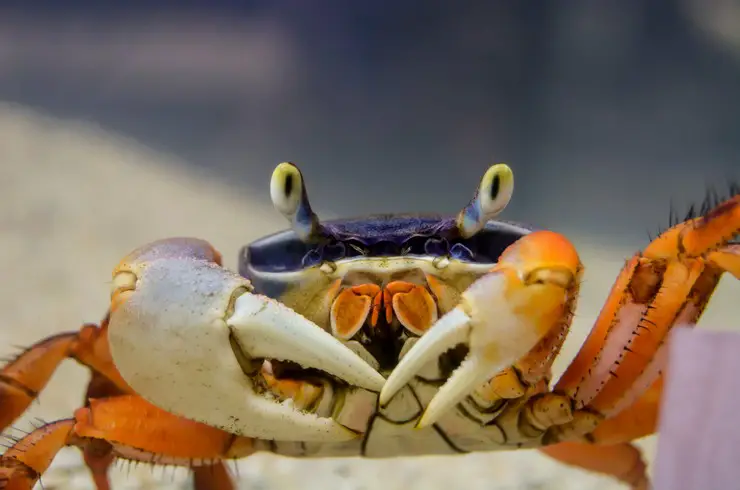
The rainbow crab cannot be called an aquatic inhabitant in the full sense of the word. Unlike most other crabs, the main environment of his life island, but he needs water during molting and for breeding. This is important to remember when setting up an aqua terrarium for keeping rainbow crab.
In nature, crabs live in deep (up to one meter) and moist burrows. Food is searched for in the adjacent territory, but if it becomes scarce, then they easily go long distances deep into the mangrove forests. However, they always return to their home, finding this place without difficulty.
Raising rainbow crab in captivity is extremely difficult, so individuals caught in the wild go on sale.
Appearance
The rainbow crab is an extremely attractive aquarium inhabitant. It has a rounded body, covered with a strong carapace. The tail is missing. On the sides of the body are five pairs of walking legs, and the front pair has pincer-like pincers. They have different sizes, one claw serves for protection (pushing off the opponent), and the other for the selection of food. The jaws are located in front of the body, two eyes rise above them on short movable stalks.
Rainbow crabs are large crustaceans, they can grow up to 16 cm or more in length, although at home they are usually smaller.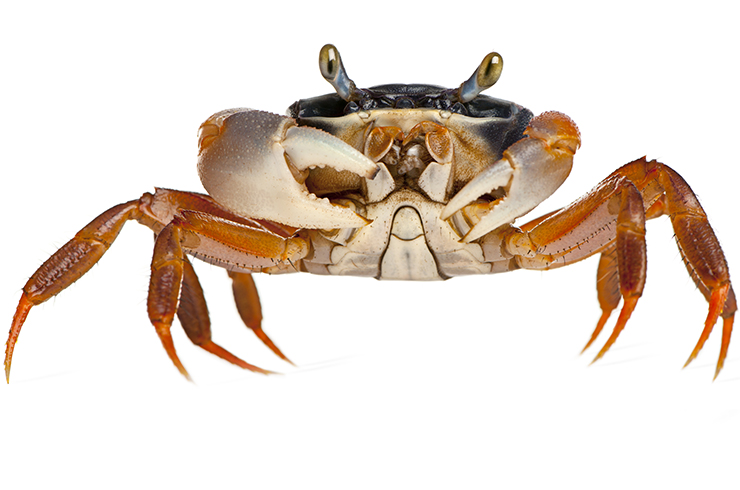
The color of these representatives of the animal world is simply amazing, it is not for nothing that they were nicknamed “rainbow”. The upper part of the carapace can range from bright blue to purple. The walking legs are orange or blood red. The abdomen is light or blue. The grasping limbs can be red or blue, the claws are usually white. Males are characterized by brighter coloration than females.
Life expectancy at home is 8-10 years.
Habitat
The rainbow crab is widespread throughout the Atlantic coast of Africa, from Senegal to Angola.
It lives nearby in coastal mangroves, where it digs deep holes in the sand. Crabs remain loyal to their house, they always return to it. Sometimes uninvited guests are found there, and a showdown begins. The winner can stay in the hole, the loser is forced to dig a new one.
Home care and maintenance
The most important thing for creating a comfortable life for a crab is a properly equipped terrarium. If the crustacean is kept alone, then the territory of 40×40 cm will be enough for it, but if you plan to have a pair, then it is better to stop at a container of 80×50 cm.
In nature, the rainbow crab spends most of its time on land, so this should be taken into account when creating a home. There are two main approaches:
- The aquarium is filled with water, the level of which should not exceed 15 cm, and a variety of decorations (driftwood, stones, grottos), towering above the surface of the water, will serve as the place of exit to land;
- A wet terrarium is set up in the container, and a small plastic container is placed for the water, which serves as a pool.
In any case, the presence of an island of land is a prerequisite for a comfortable life for a rainbow crab.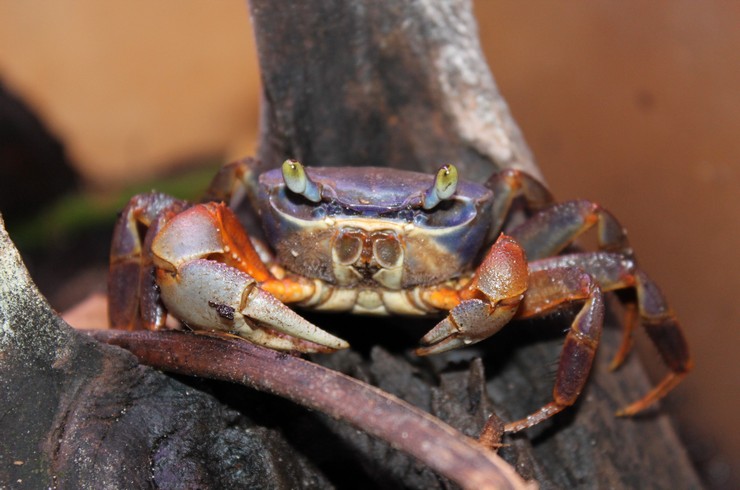
Crabs, including rainbow crabs, are real escape experts. Therefore, make sure that the aqua terrarium is equipped with a heavy lid that the crab cannot lift, and the technological holes are small. Unfortunately, an escaped crab is doomed to die in a short period of time, since its gills will dry out quickly in low humidity conditions. If the escape did happen, then the best way to lure the fugitive would be to install a damp cloth or shallow container of water in the room. Rainbow crabs feel the water very well and will not fail to use the trap.
It is best to use pebbles of 3-5 mm fraction as soil. Once a week, it should be cleaned (siphoned) of waste products.
High-quality water is vital for these pets. If they live in an aquarium, then a powerful filtration system (external filter) and a good compressor must be installed. If a “pool” is used, then the water in it should be changed daily.
Many novice crab breeders ask themselves: does a rainbow crab need to add some salt to the water? In most cases (provided the total water hardness is at least 10 dGH), crabs thrive in freshwater. However, the addition of salt increases the adaptive capacity of crabs and molts more easily. Therefore, crustaceans can be kept in brackish water (2-3 g per liter). It is best to use special sea salt, which can be purchased at pet stores.
How to properly prepare water for rainbow crabs? Most often, the most accessible source of water is used to fill the aqua terrarium with crabs – the central water supply. Unfortunately, such water can be unsafe for your pets, because it often contains hazardous compounds – chlorine and heavy metals. Tetra Crusta AquaSafe Conditioner will instantly make the water fit for crabs. It also contains B vitamins to reduce stress, iodine, and magnesium for healthy shedding. Add 5 ml of product to 10 liters of water with every change.
When keeping rainbow crabs, it is very important to observe the thermal regime: the water temperature should be 24-26 ° С, and the air temperature should be 26-28 ° С. The thermostat is best hidden in a special protective casing so that the crab cannot be burned. Too high air temperature in the aqua terrarium is very dangerous, it can provoke another molt, for which the crab is not yet ready. This often ends in the death of the animal.
It is useful to plant aquatic plants in an aquarium with a rainbow crab; they perfectly absorb nitrates from the water. Unfortunately, most of them can be shared by the crab, so it is best to stop at the most unpretentious species: elodea, water hyacinth, Indian fern, hornwort, Javanese moss, Mayas, duckweed. 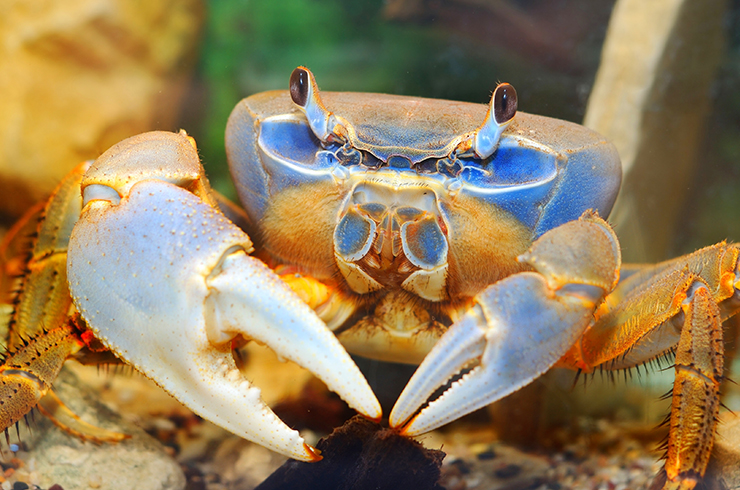
The most dangerous and crucial period in a crab’s life is molting. Its need is due to the fact that crustaceans have a strong outer cover that prevents them from growing. Therefore, growth occurs after shedding the old “skin” until the new one hardens. This process takes a lot of strength and energy from cancer.
The frequency of molting depends on the age of the animal: young individuals can be renewed every 10 days, adults usually 2-3 times a year. In the process of molting, limbs are restored, so if the crab has lost them for some reason, there is no serious cause for concern.
Molting occurs in water, while the crab is always in the shelter and does not feed. Usually, the process of shedding the old cover takes from 10 minutes to half an hour. After that, the crab needs a rest for rehabilitation for three days, at this time it is better not to disturb it, it is also not worth doing a water change. For correct shedding, the water must have a sufficient amount of minerals (its total hardness must not be less than 8 dB). The discarded cover should not be removed from the aquarium. When the crab gets stronger, it will eat it, making up for the lack of nutrients in the body.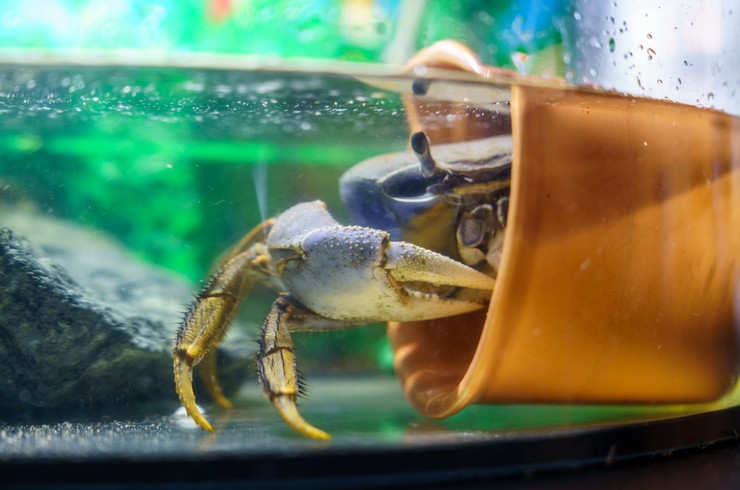
Can I handle crabs? With a certain amount of skill, this can be done, however, in each case, he will try to pinch you with a claw, in resourcefulness this animal can only be envied. The “bite” is not dangerous, but rather unpleasant, so it’s better not to touch the crabs once again. It is best to take them from above and from behind. If the crab pinches the owner, and he jerks abruptly, then this often ends in the loss of a limb for the pet.
But these animals are very easy to teach to take food out of hand. The main thing is to offer the crab tasty treats and not make any sudden movements. Very soon the crustacean will enter from its hiding place as soon as it spots you. By the way, many people note the “curiosity” of rainbow crabs. You can see how he looks out of the ambush for a long time, checking what is happening in the room.

